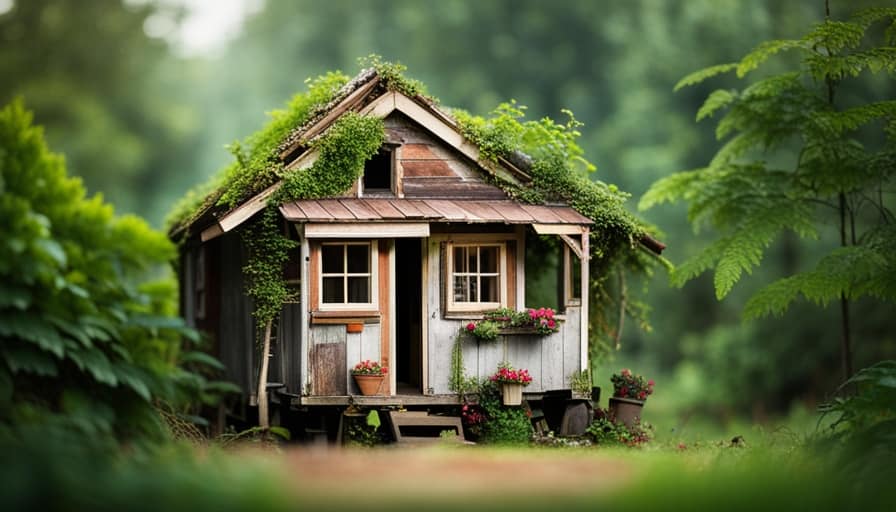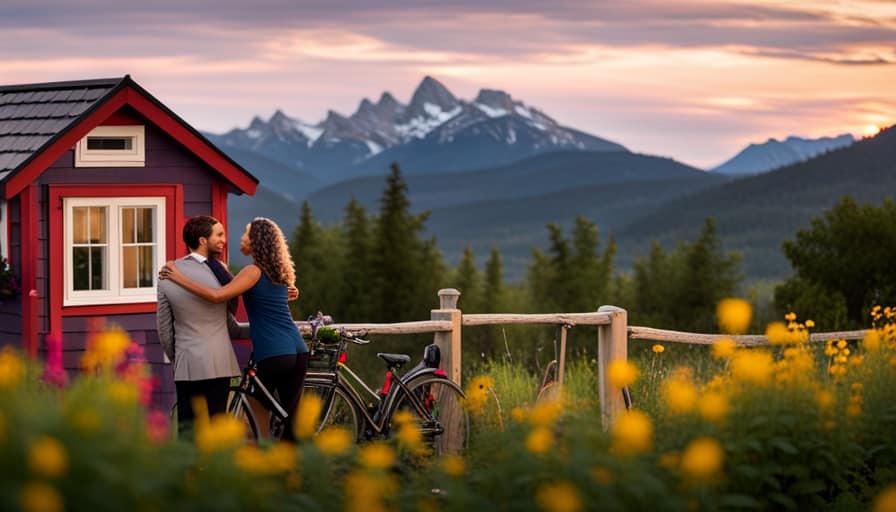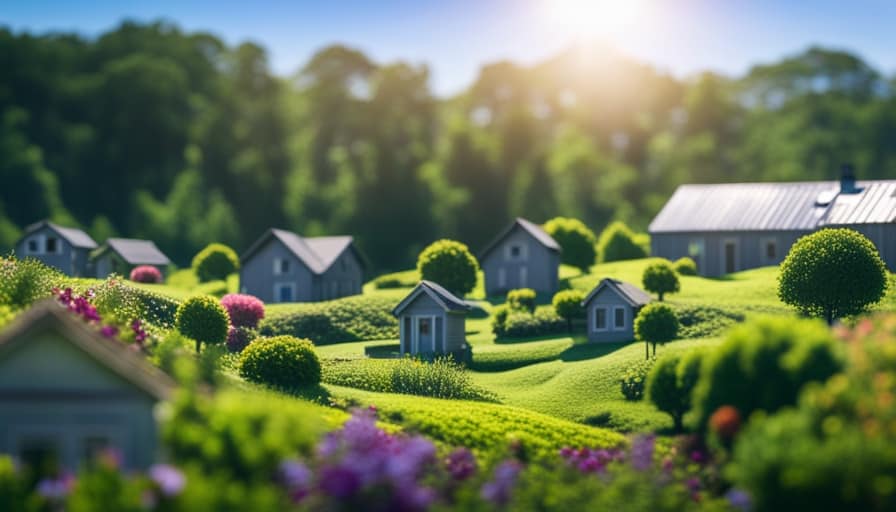As an owner of a small house, I have frequently pondered how to optimize my limited space. It’s not simply about reducing size, but about discovering inventive storage solutions, maximizing natural light and airflow, and creating unique floor plans.
In this article, I’ll share tips and strategies that have helped me turn my tiny house into a functional and versatile home. Whether you’re a fellow tiny house enthusiast or simply looking to optimize your living space, these ideas will serve you well.
Key Takeaways
- Regular decluttering and maintaining order is crucial in downsizing and preventing accumulation of unnecessary belongings.
- Utilize storage solutions such as multi-functional furniture, vertical storage options, hidden compartments, and shelves or cabinets under stairs to maximize space.
- Maximize natural light and airflow by incorporating skylights or solar tubes, using light-colored surfaces, strategically placing windows, and increasing energy efficiency.
- Design creative floor plans and outdoor spaces, such as loft-style layouts, flexible room dividers, outdoor living areas, and incorporating large windows and skylights for natural light.
Downsizing Strategies: Making the Most of Limited Space
I’ll share my favorite downsizing strategies to maximize the limited space in my tiny house.
Small space organization is key when it comes to minimalistic living. One effective strategy is to declutter regularly and only keep items that are essential and bring joy. This helps create a sense of order and prevents the accumulation of unnecessary belongings.

Another strategy is to utilize multi-functional furniture, such as a sofa that can be converted into a bed, or a coffee table with built-in storage. This allows for a more efficient use of space without compromising on functionality.
Additionally, using vertical storage solutions, such as wall-mounted shelves or hanging organizers, can help maximize storage capacity.
By implementing these downsizing strategies, I’ve been able to create a well-organized and comfortable living space in my tiny house.
Now, let’s move on to exploring innovative storage solutions for tiny houses.

Innovative Storage Solutions for Tiny Houses
Sometimes, but, I struggle to find enough storage space in my tiny house. However, there are innovative storage solutions that can help maximize the limited space available.
One option is hidden storage, which allows you to utilize every nook and cranny in your tiny house. For example, you can install shelves or cabinets under stairs, or use storage ottomans that double as seating.
Another solution is space-saving furniture, such as folding tables or murphy beds. These furniture pieces can be easily tucked away when not in use, creating more room to move around.
Additionally, utilizing vertical space by installing tall cabinets or shelves can help make the most of your tiny house.

Maximizing Natural Light and Airflow in a Compact Home
There are several ways to maximize natural light and airflow in my compact home. By increasing energy efficiency and incorporating green design elements, I can create a space that isn’t only comfortable but also environmentally friendly.
Here are three strategies I can implement:
-
Installing skylights or solar tubes: These allow natural light to enter the home, reducing the need for artificial lighting during the day. They also provide ventilation, improving airflow and reducing the need for air conditioning.
-
Using light-colored, reflective surfaces: Light-colored walls, ceilings, and floors can help bounce natural light around the room, making it feel brighter and more spacious. Additionally, reflective surfaces can help distribute natural light to darker corners of the home.

-
Utilizing cross ventilation: Placing windows strategically to allow for cross ventilation can significantly improve airflow. This helps keep the home cool and reduces the reliance on air conditioning.
Creative Floor Plans to Open Up Your Tiny House
One option to consider when looking to open up my tiny house is a loft-style floor plan. This design involves having an elevated sleeping area, which allows for more usable space underneath. By utilizing a loft, I can create a separate sleeping area that doesn’t take up valuable floor space.
Additionally, I can incorporate flexible room dividers to further maximize the functionality of the space. These dividers can be moved or adjusted as needed, creating separate areas for living, working, and dining.
Another way to open up my tiny house is by creating outdoor living spaces. This could include a patio or deck area, which extends the usable space of the house and provides an opportunity for outdoor entertaining and relaxation.

Incorporating these creative floor plans will help me make the most of my tiny house and create a more open and spacious living environment.
Designing Multifunctional Furniture for Versatile Living Spaces
When designing multifunctional furniture for my versatile living space, I can explore options that maximize functionality and save valuable space. Here are some ideas to consider:
-
Modular Seating:
Having modular seating allows for flexibility in arranging and rearranging furniture to suit different needs. Modular pieces can be easily moved and reconfigured to create different seating arrangements, such as a sofa, a sectional, or individual chairs. -
Hidden Storage:
Utilizing hidden storage solutions is essential in a small living space. Furniture pieces like ottomans, coffee tables, and bed frames can be designed with built-in storage compartments. These hidden storage areas provide a place to store items like blankets, books, or even extra kitchen supplies, keeping them out of sight but easily accessible.
-
Convertible Furniture:
Investing in convertible furniture is another great way to maximize functionality. Items like sofa beds, folding tables, and wall-mounted desks can serve multiple purposes, allowing you to transform your living space as needed.
Frequently Asked Questions
Are There Any Legal Restrictions or Regulations on Living in a Tiny House?
Legal restrictions and zoning regulations vary depending on your location. It is important to research and understand the laws and regulations in your area before living in a tiny house to ensure compliance and avoid any legal issues.
How Much Does It Cost to Build a Tiny House?
Building a tiny house requires careful budgeting and cost estimation. Financing options such as personal loans or RV loans can help cover expenses. It’s important to consider all the factors to ensure a successful and affordable project.
How Do I Find Suitable Land to Park My Tiny House On?
To find suitable land for my tiny house, I research affordable options and check zoning requirements. This ensures I comply with regulations and find a location that meets my needs.

What Are Some Common Challenges of Living in a Tiny House?
Living in a tiny house has its challenges. The cost of maintenance can be higher due to limited space and specialized systems. Maximizing storage space is crucial, requiring efficient organization and creative solutions.
Can I Customize the Exterior of My Tiny House to Reflect My Personal Style?
Yes, you can customize the exterior of your tiny house to reflect your personal style. There are various personalization options available, allowing you to create a unique and aesthetically pleasing exterior design.
Conclusion
In conclusion, by implementing downsizing strategies, utilizing innovative storage solutions, maximizing natural light and airflow, and designing multifunctional furniture, you can transform your tiny house into a comfortable and functional living space.
As the saying goes, ‘Less is more,’ and in the case of tiny houses, this adage holds true. Embrace the challenge of limited space and let your creativity shine as you create a truly unique and efficient home.

I’m Theodore, and I love tiny houses. In fact, I’m the author of Tiny House 43, a book about tiny houses that are also tree houses. I think they’re magical places where imaginations can run wild and adventures are just waiting to happen.
While tree houses are often associated with childhood, they can be the perfect adult retreat. They offer a cozy space to relax and unwind, surrounded by nature. And since they’re typically built on stilts or raised platforms, they offer stunning views that traditional homes simply can’t match.
If you’re looking for a unique and romantic getaway, a tree house tiny house might just be the perfect option.










